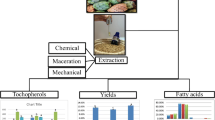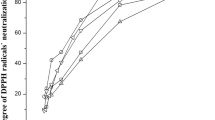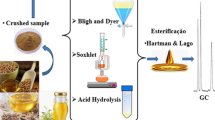Abstract
Most of the seeds produced by neem (Azadirachta indica A. Juss) trees in Nigeria are currently underutilized. Hence, relevant literature provides only limited information concerning many of the seed oils from this country, especially where it concerns the potential applications of these oils as preservatives for ligno-cellulose against bio-deterioration. Using standard procedures therefore, this study was carried out to evaluate and document selected physical and chemical properties of neem seed oil (NSO), mechanically extracted using a cold press at 31.03 N·mm−2 pressure and a room temperature of 25 ± 2°C. The results show that oil yield was 38.42% with a specific gravity of 0.91 ± 0.01. The amount of acid was 18.24 ± 1.31 mg KOH·g−1 and that of iodine 93.12 ± 2.01 g·100 g−1, while saponification and peroxide values were 172.88 ± 2.06 and 1.42 ± 0.04 mg·g−1 respectively. The implication of the values obtained, particularly those for the chemical properties, as they concern the potential application of NSO as a preservative for ligno-cellulose, is likely that it may be useful in this regard since the values may support some of the documented anti-microbial properties of the oil, although other physical and chemical properties that may affect this potential are recommended for investigations. Conclusions and other recommendations follow in line with the results of the study.
Similar content being viewed by others
References
Abdullah B M, Salimon J. 2009. Physicochemical characteristics of malaysian rubber (Hevea brasiliensis) seed oil. Eur J Sci Res, 31(3): 437–445
Abu-Arabi M K, Allawzi M A, Al-Zoubi H S, Tamimi A. 2000. Extraction of Jojoba oil by pressing and leaching. Chem Eng J, 76: 61–65
Adebowale K O, Adedire C O. 2006. Chemical composition and insecticidal properties of the underutilized Jatropha curcas seed oil. Afr J Biotechnol, 5(10): 901–906
Adeeko K A, Ajibola O O. 1990. Processing factors affecting yield and quality of mechanically extracted groundnut oil. J Agric Eng, 45: 31–43
Akpan U G. 1999. Extraction and characterization of neem seed oil. In: Eyo A A, Aloku P O, Garba S A, Ali U D, Lamai S L, Olufeagba S O, eds. Biotechnology and Sustainable Development in Nigeria. Proceedings of the 12th Annual Conference of the Biotechnology Society of Nigeria. Aluko, Nigeria, 63–66
AOAC Official Method 965.33, Peroxide Value of Oils and Fats. 2002. In: Horwitz W, ed. Official Methods of Analysis of AOAC International. 41.1.16. 17th Edition. Gaithersberg, MD: AOAC International
ASTM D 5558-95. 2006. Standard Test Method for Determination of the Saponification Value of Fats and Oils. American Society for Testing and Materials
ASTM D 5768-02. 2006. Standard Test Method for Determination of Iodine Value of Tall Oil Fatty Acids. American Society for Testing and Materials
ASTM D 974-08. 2008. Standard Test Method for Acid and Base Number by Color-Indicator Titration. American Society for Testing and Materials
Bhatnagar D, McCormick S P. 1988. The inhibitory effect of neem (Azadirachta indica A. Juss) leaf extracts on aflatoxin synthesis in Aspergillus parasiticus. J Am Oil Chem Soc, 65: 1166–1168
Chavan S R, Nikam S T. 1988. Investigation of alkanes from neem leaves and their mosquito larvicidal activity. Pesticides, 22(7): 32–33
Das R K. 1982. Industrial Chemistry. Part II. New Delhi, India: Kalyani Publishers, 250–259
Dhingra S, Kapoor A C. 1985. Nutritive value of mango seed kernel. J Sci Food Agr, 6: 752–756
Dhyani S, Tripathi S, Indra D. 2004. Preliminary screening of neem (Azadirachta indica) leaf extractives against Poria monticola-a wood destroying fungus. J Ind Acad Wood Sci, 1–2: 103–112
Erakhrumen A A. 2010. Potentials of neem (Azadirachta indica A. Juss) seed oil as a preservative for bamboo (Bambusa vulgaris Schrad. ex J.C. Wendl.) against basidiomycetes. An Unpublished thesis for Ph.D. degree submitted to the Department of Forest Resources Management, University of Ibadan, Ibadan, Nigeria
Fasina O O, Ajibola O O. 1989. Mechanical extraction of oil from conophor nut (Tetracarpadium conophorum). J Agric Eng Res, 44: 275–287
Gripenberg J. 1949. The constituents of the wood of Thuja occidentalis L. Acta Chem Scand, A3(7): 782
Gunstone F D, John L H, Fred B P. 1994. The Lipid Hand Book. 2nd edn. New York: Chapman & Hall Publishing
Holmbom B, Avela E. 1971a. Studies of tall oil from pine and birch. I. Composition of fatty and resin acids in sulphate soaps and in crude tall oils. Acta Acad Aboens, B 31: 13
Holmbom B, Avela E. 1971b. Studies of tall oil from pine and birch. ii. unsaponifiable constituents in sulphate soaps and in crude tall oils. Acta Acad Aboen, B31: 16
Holmbom B, Stenius P. 2000. Analytical methods. In: Stenius P, ed. Papermaking Science and Technology, Forest Products Chemistry. Book 3. Finland: Fapet Oy
Islam M M, Shams M I, Ilias G N M, Hannan M O. 2009. Short communication: protective antifungal effect of neem (Azadirachta indica) extracts on mango (Mangifera indica) and rain tree (Albizia saman) wood. Intl Biodeterior Biodegrad, 63: 241–243
Koski A. 2008. Applicability of Crude Tall Oil for Wood Protection. Dissertation for the Doctoral Degree. Oulu, Finland: Faculty of Technology, University of Oulu, 293
Kurian A. 2010. Determination of Specific Gravity of Clove Oil. http://www.indiastudychannel.com/projects/4491-Determination-Of-Specific-Gravity-Of-Clove-Oil.aspx. Accessed 5 April 2011
Kurucheve V, Ezhilalnad G J, Jayraj J. 1997. Screening of higher plants for fungitoxicity against Rhizoctonia solani in vitro. Ind Phytopathol, 50(2): 235–241
Laks P E, McKaig P A, Hemingway R W. 1988. Flavonoid biocides: wood preservatives based on condensed tannins. Holzforschung, 42: 299–306
Liauw M Y, Natan F A, Widiyanti P, Ikasari D, Indraswati N, Soetaredjo F E. 2008. Extraction of neem oil (Azadirachta indica A. Juss) using N-hexane and ethanol: studies of oil quality, kinetic and thermodynamic. ARPN J Eng Appl Sci, 3(3): 49–54
Locke J C. 1995. Fungi. In: Schmutterer H, ed. The Neem Tree, Source of Unique Natural Products for Integrated Pest Management, Medicine, Industry and Other Purposes. Weinheim, Germany: VCH, 118–125
Lotz R W, Hollaway D F. 1993. Wood Preservation. United States Patent No. 4732817
Lotz R W. 1993. Wood Preservation Systems Including Halogenated Tannin Extracts, United States Patent No. 5270083
Lyon F, Thevenon M-F, Hwang W-J, Imamura Y, Gril J, Pizzi A. 2007. Effect of an oil heat treatment on the leachability and biological resistance of boric acid impregnated wood. Ann Forest Sci, 64: 673–678
Majid M A, Rahman I M M, Shipar M A H, Helal Uddin M, Chowdhury R. 2004. Physico-chemical characterization, antimicrobial activity and toxicity analysis of Swietenia mahagoni seed oil. Intl J Agric Biol, 6(2): 350–354
Majumder S M M H, Alam S A, Mistry A C, Azadi M A. 1997. Studies on the physico-chemical properties and toxicity analysis of neem (Azadirachta indica) seed oil and analysis of the seed cake. J Bang Chem Soc, 10: 221–227
Mishra A K, Singh N, Sharma V P. 1995. Use of neem oil as a mosquito repellent in tribal villages of mandla district, Madhya Pradesh. Ind J Malariol, 32(3): 99–103
Mitchell R, Sleeter T D. 1980. Protecting Wood from Wood Degrading Organisms. United States Patent No. 4220688
Mitra C R. 1963. Neem. Hyderabad, India: Indian Central Oil Seeds Committee
Mongkholkhajornsilp D, Douglas S, Douglas P L, Elkamel A, Teppaitoon W, Pongamphai S. 2004. Supercritical CO2 extraction of nimbin from neem seeds-a modeling study. J Food Eng, 71: 331–340
Mwithiga G, Moriasi L. 2007. A study of yield characteristics during mechanical oil extraction of preheated and ground soybeans. J Appl Sci Res, 3(10): 1146–1151
Neem Foundation (NF) 2006. About Neem. http://www.neemfoundation.org/aboutneem.htm. Accessed 5 April 2011
Nourredini H, Teoh B C, Clements L D. 1992. Viscosities of vegetable oils and fatty acids. J Am Chem Soc, 69: 1184–1188
Nzikou J M, Matos L, Bouanga-Kalou G, Ndangui C B, Pambou-Tobi N P G, Kimbonguila A, Silou T, Linder M, Desobry S. 2009. Chemical composition on the seeds and oil of sesame (Sesamum indicum L.) grown in Congo-Brazzaville. Adv J Food Sci Technol, 1(1): 6–11
O’Brien R D. 2004. Fats and Oils. Formulating and Processing for Applications. 2nd Edn. Washington DC: CRC Publishing
Office of Internal Affairs (OIA) and Policy and Global Affairs (PGA). 1992. Neem: A Tree for Solving Global Problem. Washington: The National Academies Press
Onyeike E N, Acheru G N. 2002. Chemical composition of selected Nigerian oil seeds and physicochemical properties of the oil extracts. Food Chem, 77: 431–437
Parveen G, Alam M M. 1993. Bioactivity against plant pathogens. In: Randhawa N S, Parmar B S, eds. Neem Research and Development. New Delhi, India: Society of Pesticide Science, 144–153
Porter N A, Lehman L S, Weber B A, Smith K J. 1981. Unified mechanism for polyunsaturated fatty acids autoxidation. competition of peroxy radical hydrogen atom abstraction, β-scission, and cyclization. J Am Chem Soc, 103(21): 6447–6455
Porter N A, Wujek D G. 1984. Autoxidation of polyunsaturated fatty acids, an expanded mechanistic study. J Am Chem Soc, 106(9): 2626–2629
Puri H S. 1999. Neem: The Divine Tree. Azadirachta indica. Amsterdam, the Netherlands: Harwood Academic Publications
Rao R V. 1990. Natural decay resistance of neem wood. J Ind Acad Wood Sci, 21(1): 19–21
SathyaSelvabala V, Varathachary T K, Selvaraj D K, Ponnusamy V, Subramanian S. 2010. Removal of free fatty acid in Azadirachta indica (neem) seed oil using phosphoric acid modified mordenite for biodiesel production. Biores Technol, 101(15): 5897–5902
Sobrinho Jr A S, de Aragão Jr J L, Torres S M, de Barros S, Ortiz S R, Barbosa N P. 2009. Bamboo pH and Absorption in Different Liquids. Proceedings of the 11th International Conference on Non-conventional Materials and Technologies (NOCMAT 2009), Bath, UK. http://opus.bath.ac.uk/16170/1/papers/Paper%20155.pdf. Accessed 5 April 2011
Soetaredjo F E, Budijanto G M, Prasetyo R I, Indraswati N. 2008. Effects of pre-treatment condition on the yield and quality of neem oil obtained by mechanical pressing. ARPN J Eng Appl Sci, 3(5): 45–49
Stirling R, Daniels C R, Clark J E, Morris P I. 2007. Methods for determining the role of extracts in the natural durability of western red cedar heartwood. Document No. IRG/WP 07-20356. The International Research Group on Wood Preservation, Sweden
Subbaraman R B, Brucker B R. 2001. Method for Using Neem Extracts and Derivatives for Protecting Wood and other Cellulosic Composites. United States Patent No. 6294571
Swathi D, Tripathi S, Dev I. 2004. Preliminary screening of neem (Azadirachta indica) leaf extractives against Poria monticola-a wood destroying fungus. J Ind Acad Wood Sci, (N.S.)1: 103–112
Tewari D N. 1992. A Monograph on Bamboo. Dehradun, India: International Book Distributors
Uquiche E, Jerez M, Ortíz J. 2008. Effect of pretreatment with microwaves on mechanical extraction yield and quality of vegetable oil from chilean hazelnuts (Gevuina avellana Mol). Innov Food Sci Emerg Technol, 9: 495–500
Venmalar D, Nagaveni H C. 2005. Evaluation of copperised cashew nut shell liquid and neem oil as wood preservatives. IRG/WP 05-30368. The 36th Annual Meeting of the International Research Group on Wood Protection. Bangalore, India
Wicks Jr Z W, Jones F N, Pappas S P. 1992. Organic Coatings: Science and Technology. Volume 1: Film Formation, Components and Appearance. New York: John Wiley & Sons Inc., 133–143
Wikipedia. The Free Online Encyclopedia, Neem oil. 2007. http://en.wikipedia.org/wiki/Neem_oil. Accessed 5 April 2011
Yang D Q. 2009. Potential utilization of plant and fungal extracts for wood protection. Forest Prod J, 59(4): 97–103
Yong O Y, Jumat S. 2006. Characteristics of Elateriospermum tapos seed oil as a new source of oil seed. Ind Crop Prod, 24: 146–151
Author information
Authors and Affiliations
Corresponding author
Rights and permissions
About this article
Cite this article
Erakhrumen, A.A. Selected physical and chemical properties of mechanically extracted neem seed oil sourced as a preservative for ligno-cellulose in southwestern Nigeria. For. Stud. China 13, 263–269 (2011). https://doi.org/10.1007/s11632-013-0402-8
Received:
Accepted:
Published:
Issue Date:
DOI: https://doi.org/10.1007/s11632-013-0402-8




